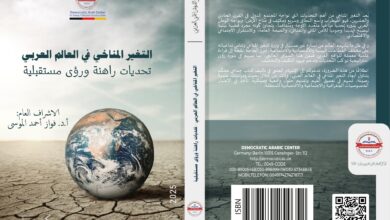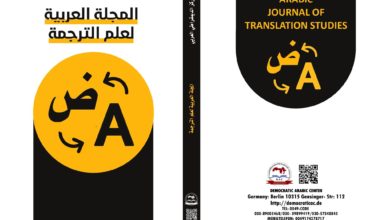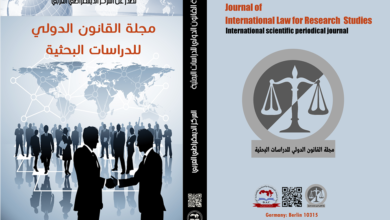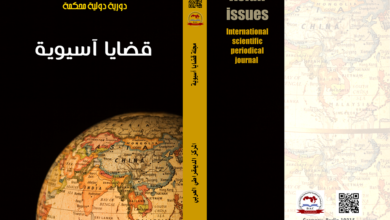دراسات في تاريخ اوروبا الشرقية – ميثاق وارشو دراسة في العلاقات الدبلوماسية والعسكرية 1964-1955
Studies in the history of Eastern Europe Warsaw Pact A Historical Study in the Diplomatic and Military Relations 1964-1955
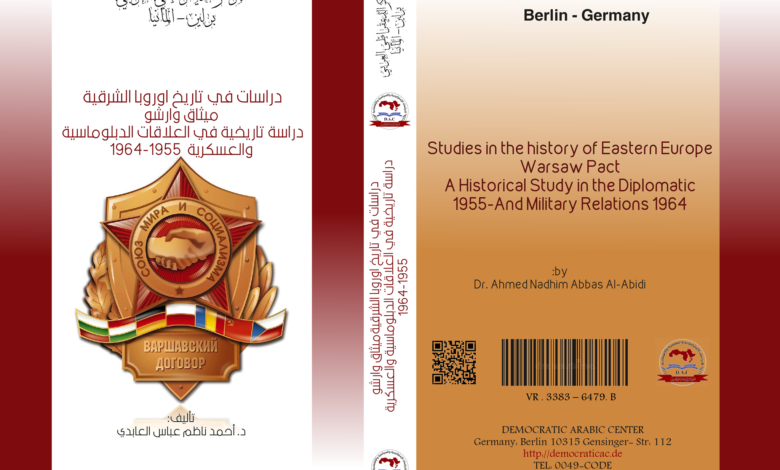
تأليف : د. احمد ناظم عباس العابدي
نسخة “pdf”-
دراسات في تاريخ اوروبا الشرقية – ميثاق وارشو دراسة في العلاقات الدبلوماسية والعسكرية 1964-1955
الطبعة الأولى “2021″ –من كتاب: –
دراسات في تاريخ اوروبا الشرقية – ميثاق وارشو دراسة في العلاقات الدبلوماسية والعسكرية 1964-1955
جميع حقوق الطبع محفوظة #المركز_الديمقراطي_العربي ولا يسمح بإعادة إصدار هذا الكتاب أو اي جزء منه أو تخزينه في نطاق إستعادة المعلومات أو نقله بأي شكل من الأشكال، دون إذن مسبق خطي من الناشر .
تقديم:
هذه الأطروحة محاولة لفهم العوامل والمتغيرات التي أدت الى تشكيل ميثاق وارشو, وتحديد الأدوار التي قام بها الميثاق خلال مرحلة مهمة من مراحل التاريخ الأوربي التي عُرفت بـ”الحرب الباردة”.
ارتبطت الإشكالية المركزية في هذه الأطروحة بعنوانها [ميثاق وارشو دراسة تاريخية في العلاقات الدبلوماسية والعسكرية 1955-1964], الذي يتناول عدة مسائل شائكة في النواحي الدبلوماسية والعسكرية الأوربية, آذ جاء اختيار الموضوع في كونه جزء من تطورات الحرب الباردة وتداعياتها على الأمن والسلم الدوليين, وما يرتبط بهما من مسائل سياسية ودبلوماسية وعسكرية. ووفقا لذلك فقد جاءت الإشكالية لتصحيح بعض المفاهيم فيما يخص تشكيل الميثاق منها؟ هل شُكل ميثاق وارشو رداً على التحالف الأطلسي, واذا كان نعم؟ لماذا تأخر قرابة ستة سنوات, وهل نجح في صد تطلعات الناتو؛ وإذا لا؟ ما هي المبررات التي أدت الى تشكيل الميثاق, والى أي مدى كان تأثير القضية الألمانية سببا في تشكيل الميثاق؟ وهل كان وجودة امراً لازما؟ وهل نشأ كتحالف عسكري ام دبلوماسي؟ وما هي دوافع السوفيت في تشكيله, هل كان لأسباب دفاعية أمنية, ام وسيلة دعائية لزيادة مكانة الاتحاد السوفيتي دبلوماسياً؟ وهل جاء على وجه السرعة, ام انه كان ضمن الحسابات السوفيتية؟ لماذا عُقد الاجتماع الذي تمخض عن الميثاق في إحدى المدن الأوربية الشرقية وبالذات وارشوا بدلاً من موسكو؟ وما هي الأسس والمبادئ التي قام عليها؟ هل شكل نتيجةً لتهديدات خارجية تلقاها الاتحاد السوفيتي, ام حلفائه في أوربا الشرقية, هل نجح الميثاق في تعزيز امن الاتحاد السوفيتي وحلفائه في أوربا؟ بماذا عاد الميثاق على الاتحاد السوفيتي وكيف قابلت الدول الأعضاء الميثاق, وما مردود تشكيله عليها؟ كيف واجهت الدول الغربية ولاسيما, الولايات المتحدة تشكيل الميثاق؟ هل نجح في حل القضايا لدبلوماسية العالقة, والى أي مدى اختبر الميثاق في القضايا العسكرية. هذا ما سنتطرق له في ثنايا الأطروحة.
تناول الفصل الأول مدخل تاريخي عن القضية الألمانية وأثرها في العلاقات الأميركية السوفيتية حتى تشكيل ميثاق وارشو 1955. قُسم الفصل إلى مبحثين, تناول المبحث الأول مسالة تقسيم ألمانيا وإثرها في العلاقات الأميركية السوفيتية 1945-1949, أما المبحث الثاني تناول المحاولات الأميركية لتسليح ألمانيا الاتحادية والموقف السوفيتي منها 1949- 1954, اذ اهتم بالضرورات التي دفعت بالولايات المتحدة إلى تبني قرار تسليح ألمانيا.
دَرسَ الفصل الثاني, ميثاق وارشو – التأسيس- الهيكلية – الوظائف التنظيمية 1955-1964, اذ قُسم إلى ثلاثة مباحث, تناول المبحث الأول انضمام ألمانيا الاتحادية إلى حلف شمال الأطلسي وإثره في انبثاق ميثاق وارشو 1954-1955, في حين تناول المبحث الثاني الجهود السوفيتية لتشكيل ميثاق وارشو 1955, وذلك من خلال توضيح الأسباب الكاملة التي دفعت بالاتحاد السوفيتي نحو إعلان تشكيل ميثاق وارشو, وهل كان ضرورة لازمة, أما المبحث الثالث فقد دَرسَ هيكلية ميثاق وارشو وتحديد المسؤوليات التنظيمية والإدارية, وذلك من خلال توضيح أهم تشكيلات الميثاق الإدارية والسياسة والعسكرية بوصفه منظمة دولية.
كُرس الفصل الثالث لدراسة المنظومة العسكرية في ميثاق وارشو وتحديد المسؤوليات 1955-1964, آذ اهتم الفصل في بيان القدرات ولإمكانيات التي يتمتع بها الميثاق من حيث القوة البشرية وإمكانياته وقدراته التسليحية. قُسم الفصل إلى ثلاثة مباحث, تناول المبحث الأول, الإمكانيات والقدرات العسكرية السوفيتية. أما المبحث الثاني, فقد تناول, الإمكانيات والقدرات العسكرية للدول الأعضاء في ميثاق وارشو, من خلال توضيح حجم القدرات العسكرية التي تتمتع بها كل دولة من الدول الأعضاء, خصص المبحث الثالث, لدراسة,أهمية ميثاق وارشو الإستراتيجية”, بالنسبة للاتحاد السوفيتي من جهة, ولدول الميثاق من جهة أخرى.
تناول الفصل الرابع, الأزمات داخل الكتلة الشرقية وأثرها في ميثاق وارشو 1956-1964, آذ قُسم الفصل إلى ثلاثة مباحث, تناول المبحث الأول, تداعيات الأزمتين البولندية والهنغارية خريف 1956, في ميثاق وارشو والموقف السوفيتي منها, بحث المبحث الثاني, الصراع السوفيتي – الألباني والخروج من ميثاق وارشو 1956-1961, اما المبحث الثالث فقد تناول, تحدي رومانيا داخل ميثاق وارشو والانسحاب السوفيتي منها 1958-1964.
دَرسَ الفصل الخامس, دبلوماسية ميثاق وارشو حيال القضايا الدولية 1958-1964. خصص هذا الفصل لبيان الخطوات الدبلوماسية التي سار عليها الميثاق في حل بعض القضايا الدولية العالقة, والى أي مدى كان نجاح ذلك.
Dr. Ahmed Nadhim Abbas Al-Abidi
Abstract
This thesis is an pact to understand the factors and variables that led to hold Warsaw pact and to identify the roles that the pact did during an important stage of European historical stages known as ‘The Cold War’.
The central problem of this thesis has associated with its title ‘Warsaw Pact: A Historical Study in the Diplomatic and Military Relations 1964-1955’ that addresses several problems in the European diplomatic and military aspects. The subject has been chosen as part of Cold War developments and its ramifications on the international peace and security and what is relevant to them according to politically, diplomatically and military. As a result, the study tries to correct some identifications of the pact such as: did Warsaw pact make a reply on the Atlantic Alliance, if so, why is it delayed about six years, and did it succeed in repelling the NATO ambitions, if not, what are the justifications that led to hold Warsaw pact, and to what degree was the effect of the Germanic issue a reason in holding the pact? Was it necessary? Is it started as a military or diplomatic alliance? What are the motives of the Soviet in starting it; were they for defensive security reasons, or propaganda means to increase the diplomatic status of the Soviet Union? Was the pact held urgently or within the Soviet schemes? Why was the meeting of the pact held in one of the Eastern European countries, especially Warsaw instead of Moscow? What are the principles that the pact was based on? Was the pact held as a result of external threats that the Soviet Union confronted or its allies in Eastern Europe? Did the pact succeed in supporting the security of the Soviet Union and its allies in Europe? What had the Soviet Union obtained from this pact and how did the pact members meet it, and what are its consequences on them? How did the West, especially the United States, confront holding the pact? Did it succeed in solving the pending diplomatic issues? To which degree was the pact applicable in military issues?
Chapter one deals with the historical introduction about the Germanic issue and its effect on the American-Soviet relations till the formation of the Warsaw pact in 1955. This chapter is divided into two sections. Section one studies the issue of the division of Germany and its impact on the American-Soviet relations in 1945-1949, while section two addresses the American attempts to arm Federal Germany and the Soviet attitude towards it in 1949-1954. It focuses on what necessitated the United States to adopt the decision of arming Germany.
Chapter two studies Warsaw pact – the structure – the establishment – the organisations in 1955-1964. This chapter is divided into three sections. The first section deals with joining Federal Germany to NATO and its effect on bringing forth Warsaw pact in 1954-1955, while section two addresses the Soviet efforts to hold Warsaw pact in 1955 by clarifying the entire reasons that made the Soviet Union declare the Warsaw pact and if it was a must. Section three studied the structure of Warsaw pact and identified the organisational and administrative responsibilities by clarifying the most important formations of administrative, political and military responsibilities since it is an international organisation.
Chapter three is dedicated to studying the military system in Warsaw pact and identifying the responsibilities in 1955-1964 stating the abilities and possibilities that the pact enjoys such as the human power and its armament capabilities. Chapter three is divided into three sections. Section one addresses the military-Soviet abilities and possibilities, while section two addresses the abilities and possibilities of the members in Warsaw pact by identifying the amount of military abilities of the countries. Section three is dedicated to studying the strategic importance of the Warsaw pact to the Soviet Union on the one hand, and the members on the other hand.
Chapter four tackles the crises inside the eastern league and its impact on the Warsaw pact in 1956-1964. This chapter is divided into three sections. The first one addresses the ramifications of the Polish and Hungarian crises in the autumn of 1957 in Warsaw pact and the Soviet attitude of it. The second section investigates the Soviet-Albanian struggle and leaving the Warsaw pact in 1956-1961, while section three addresses the challenge of Romania within the Warsaw pact and the Soviet withdrawal from it in 1958-1964.
Chapter five studied the diplomacy of the Warsaw pact towards the international issues in 1958-1964. This chapter is dedicated to stating the diplomatic steps that the pact followed in solving some pending international issues and how successful it was.
The dissertation has come up with a set of outcomes summarised as follows
- The Warsaw pact had to sustain the privileges that the Soviet Union achieved after the end of World War II, especially the ideological privileges in spreading the communist instructions in the eastern part of the European continent. Therefore there must be an organisation or a joint security treaty to protect the privileges and their maintenance.
- From the Soviet viewpoint, Eastern Europe is regarded a great addition to the military strategy as the Soviet considered it as an isolated area. So there must be a legal form to keep its troop there to protect the areas on the one hand, and threats and ambitions that are represented by the NATO on the other hand.
- الناشر: المركز الديمقراطي العربي للدراسات الإستراتيجية والسياسية والاقتصادية


